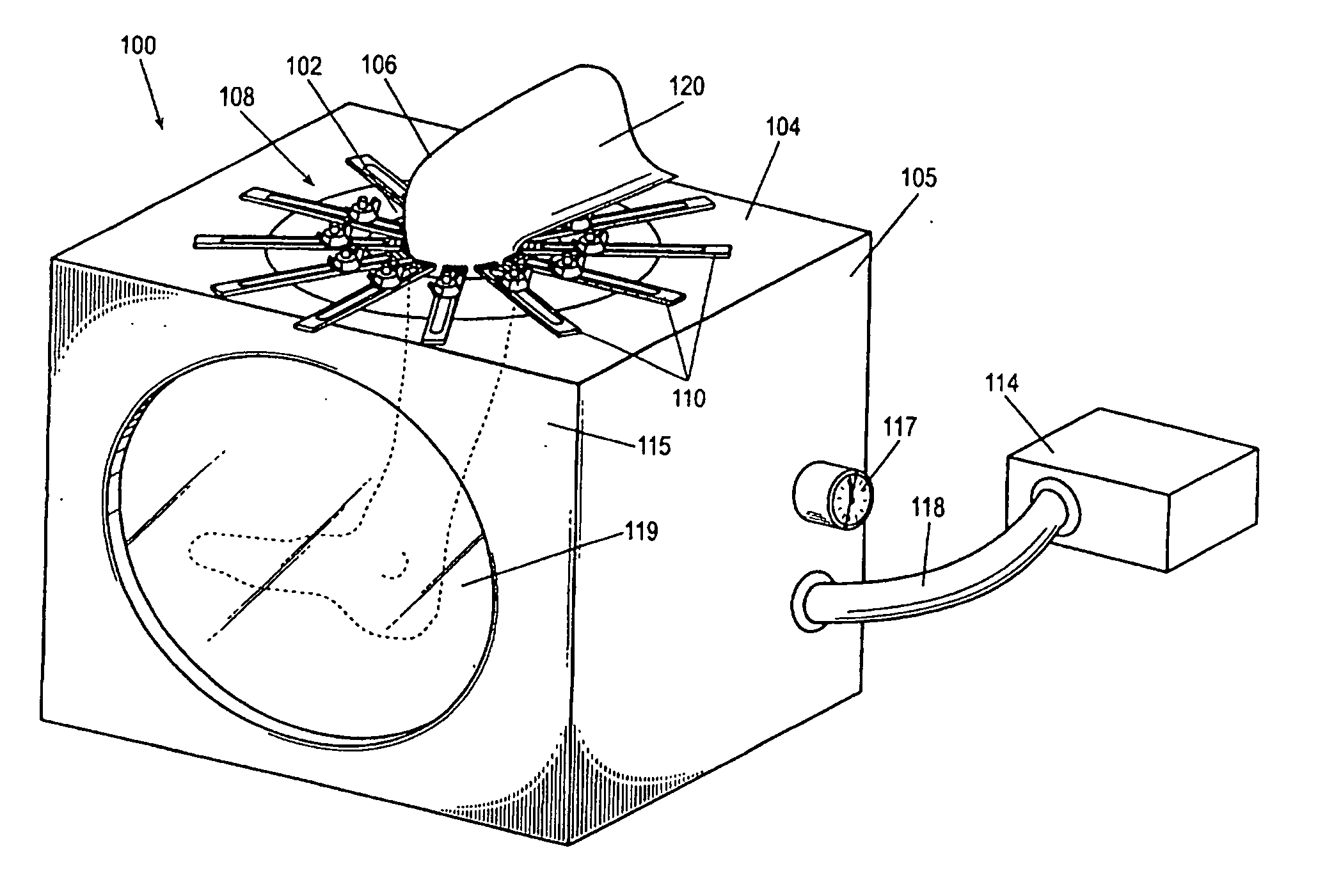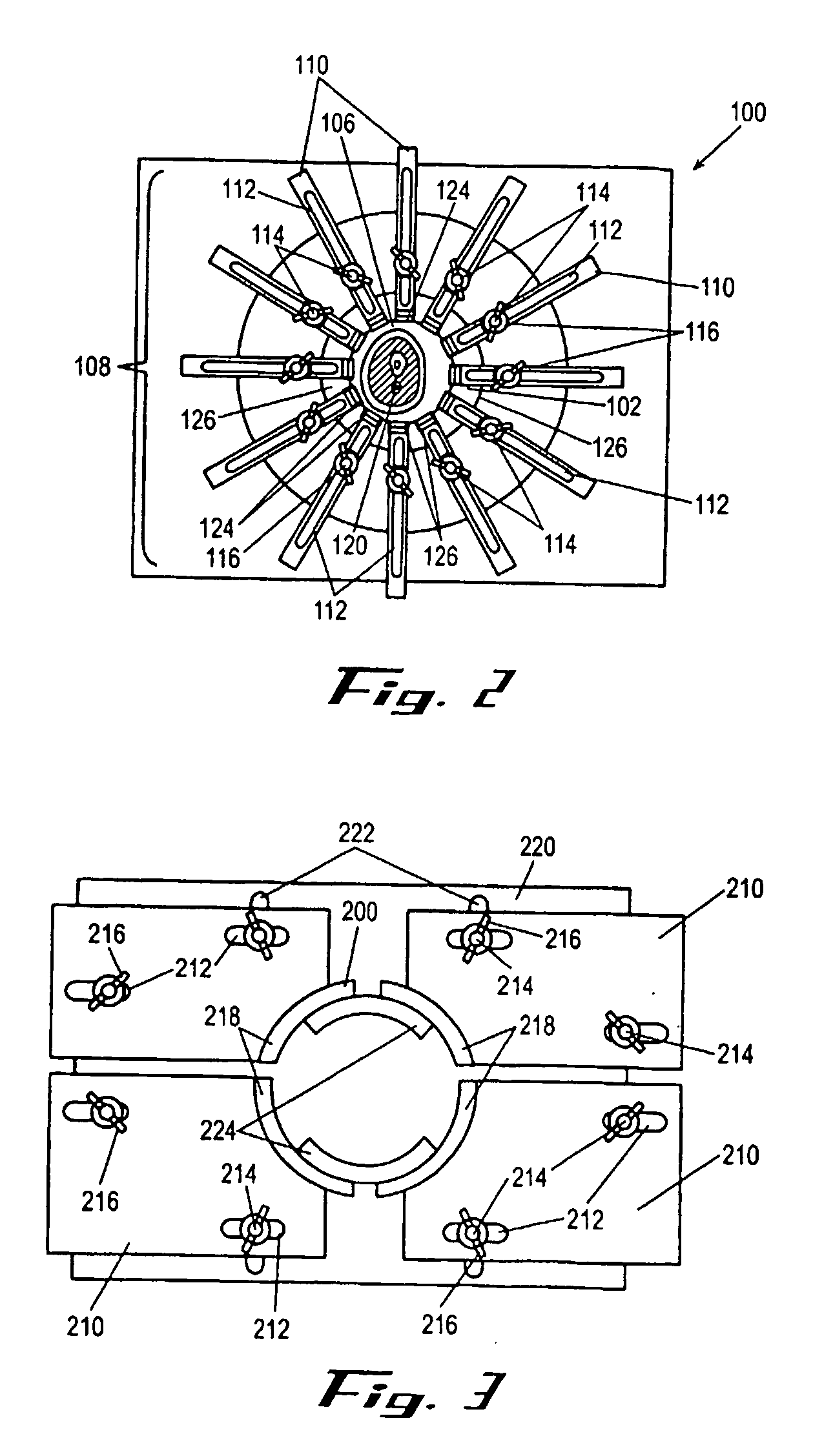Method and device to enhance skin blood flow
a microvascular and skin technology, applied in the field of hypobaric chambers, can solve the problems of slow healing of ulcers, slow healing of injuries, amputation of the affected limb, etc., and achieve the effects of enhancing skin microvascular flow, and increasing blood flow in the skin
- Summary
- Abstract
- Description
- Claims
- Application Information
AI Technical Summary
Benefits of technology
Problems solved by technology
Method used
Image
Examples
example 1
Lower Leg
[0034] The right lower legs of eight healthy male subjects, aged 22-35 years, were used. Subjects were seated and laser Doppler probes were placed at the locations indicated in FIG. 5: 1) the dorsum of the foot, 2) the medial heel, 3) the narrowest part of the ankle anterior to tibia, and 4) 5 cm below of lower edge of the kneecap. The test leg was placed in a chamber that was connected to a vacuum source and a pressure gauge. The loose seal according to the present invention was used to generate negative chamber pressure. The seal was tested at two different heights: the lower edge of the calf, above the ankle, and the maximum circumference of the calf below the knee. After a stabilization period, a test with normal, ambient pressure provided baseline control data. The chamber pressure was set at environmental pressures of −10 and −20 mmHg for each height of the loose seal. The leg was exposed to each environmental pressure for five minutes, and the chamber was returned t...
example 2
Lower Leg of Diabetes Mellitus Patient
[0038] The lower right leg of a diabetes mellitus patient (60 years old with mild Type 2 DM) was treated using similar test protocols and conditions as those described for Example 1 except that only the loose calf seal (upper seal as indicated in FIG. 5) was used. The normalized skin microvascular flow results are plotted in FIG. 7, with increases ranging from about 18 to 15 times those of the control value at the three points within the chamber for −10 mmHg. Increases produced by a negative pressure of −20 mmHg provided improvement over normal ambient pressure, from 14 to 78 times greater flow. At both mild negative pressures, the greatest improvement is seen at the heel (site 2), a common location for foot ulcers in diabetic patients, indicating that the present invention should be highly effective in promoting healing of such ulcers. Further, the present invention may be utilized as part of an on-going therapy program to prevent or minimize ...
example 3
Hand
[0039] In this example, the hypobaric chamber with non-occlusive seal according to the present invention was used in an evaluation of the effectiveness of a mechanical counter-pressure (MCP) space suit glove to simulate a low pressure environment such as would be encountered during extra-vehicular activity (EVA) during space flight. A description of this MCP glove is provided in U.S. Patent Application Publication No. US 2002 / 0116744, which disclosure is incorporated herein by reference. The right hands of 8 healthy, non-smoking male subjects, aged 22-34 years, were used. Volunteers were screened to exclude those with any past history of systemic disease or injury or surgery to their right hand.
[0040] Tests were run at negative chamber pressures of −50, −100 and −150 mmHg. In order to achieve the lower chamber pressures (−100, −150 mmHg), it was necessary to tighten the seal around the subject's wrist.
[0041] A 2.5 mm thick laser Doppler probe was placed at the dorsum of the h...
PUM
 Login to View More
Login to View More Abstract
Description
Claims
Application Information
 Login to View More
Login to View More - R&D
- Intellectual Property
- Life Sciences
- Materials
- Tech Scout
- Unparalleled Data Quality
- Higher Quality Content
- 60% Fewer Hallucinations
Browse by: Latest US Patents, China's latest patents, Technical Efficacy Thesaurus, Application Domain, Technology Topic, Popular Technical Reports.
© 2025 PatSnap. All rights reserved.Legal|Privacy policy|Modern Slavery Act Transparency Statement|Sitemap|About US| Contact US: help@patsnap.com



